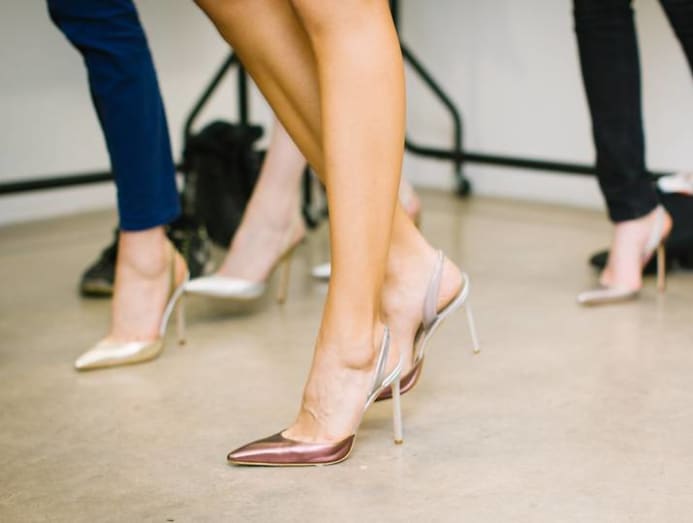Pro tips for high heel lovers: How to walk safely and elegantly in those stilettos
You may be wearing the sexiest Louboutins but if you’re not stepping right, you might walk like you’re wearing clown shoes – or worse, sprain your ankle.

(Photo: Pexels)
Whether it’s the 1990s thong heels that reality TV star Kim Kardashian seems to be reviving for 2019, or the sensible but leg-lengthening nude pumps favoured by everyone from Michelle Obama to social media influencers, heels aren’t going anywhere – except onto your feet.
There’s no doubt that heels are an instant confidence booster as they have the ability to make you look and feel taller.
But unfortunately, they can also be an instant ticket to the doctor’s if you don’t watch your steps.
At the National University Hospital’s Rehabilitation Centre, an average of three or four heels-related injuries are treated per week, said principal podiatrist Sophie Whitelaw.
In private podiatry clinics such as Physio & Sole Clinic, about 30 per cent of the foot problems seen are linked to heels.
In one of the largest studies done in the US, researchers from the University of Alabama in Birmingham estimated that more than 1.2 million heels-related injuries were treated in over 100 emergency rooms across the country from 2002 to 2012.
READ: A guide to choosing high heels that won’t torture your feet (as much)
It isn’t surprising when you think about it: We spend the first 15 months or so of our lives learning to walk – and that’s sans shoes.
When it comes to walking in heels, everyone assumes that you simply put them on and off you go.
But ask any stiletto-loving woman or yourself when you’re tottering in them, and you’ll know that your gait alters when you’re balancing on heels.

“An efficient walking gait is ideally a heel-to-toe gait, where the heel strikes the ground first, followed by the arch lowering a little to absorb shock from the ground as the foot comes down,” said Kelvin Tay, podiatrist at Physio & Sole.
“As we move forward, the arch forms again to provide a rigid lever to propel ourselves, pushing off the big toe joint.”
Unfortunately, the elevated heel of a stiletto or slingback causes you to lose the “heel-to-toe pattern”, said Whitelaw.
You end up tiptoeing or planting your entire foot down on the ground with each step in a stomping fashion.
READ: Blisters and other party feet woes: How to prevent and treat them
Both aren’t ideal gaits to adopt.
That tiptoeing action, along with squeezing your toes into a narrow toe box, can combine to create foot problems such as bunions, claw toes, plantar plate injuries, Morton's neuroma, callus formation and thickened toenails, said Lynn Li Toh, podiatrist with Physio & Sole.
There is also the issue of ankle sprains, which Whitelaw noted are common with heels, an observation that has been proven in a study.
HOW TO WALK IN HEELS
While vanity does exact a price in the form of blisters, bunions, callouses and other foot problems, heels can be just that little bit safer for you with these, well, steps.
- Walk normally, that is, heel to toe
A noob mistake to make is to land on the balls of your feet like you would when tiptoeing.
Or you may be putting your entire foot down on the ground in a stomping fashion.
Instead, walk as if you’re not in heels. That means putting your heel to the ground first, followed by your toes.
Once your weight is on the balls of your feet, shift your weight forward as if you're walking on tiptoe, and push forward for the next step.
- Improve your posture
Heels cause your lower back to arch more to compensate for the shift in your centre of gravity.
To minimise stressing your back, keep your head in line with your spine as there is a tendency for heel wearers to lean forward.
Don’t look down either when walking; in fact, your chin should be parallel with the floor.
This other tip will also help you look thinner in addition to improving your posture: Keep your abdominal muscles engaged by sucking your belly button in towards your spine.
Toh noted that it is also a good idea to bend your knees slightly and not lock them when walking in heels.
- Take small steps

This also translates into: Don’t rush. Not only will you look awkward, it is extra straining on your leg and foot muscles.
Taking smaller steps than your usual strides will also help you balance better with each step, and minimise your odds of twisting your ankle.
Some websites suggest walking in a straight line, that is, placing one foot directly in front of the other, but Tay doesn’t recommend it.
“Walking with one foot directly in front of another narrows the base of gait, which can cause instability and increase the risk of falls,” he said.
- When going down the stairs or slope
We’ve said it and we’ll say it again: Don’t rush.
This is even more crucial when going down the stairs or a gentle slope.
And for your ankle’s sake, there’s no shame in using the railing; look where you’re going and don’t be Instagramming while descending the stairs.
“When going down narrow steps, it would be better to turn sideways to allow your entire foot to be placed on the step first before shifting your weight on it,” said Toh.





